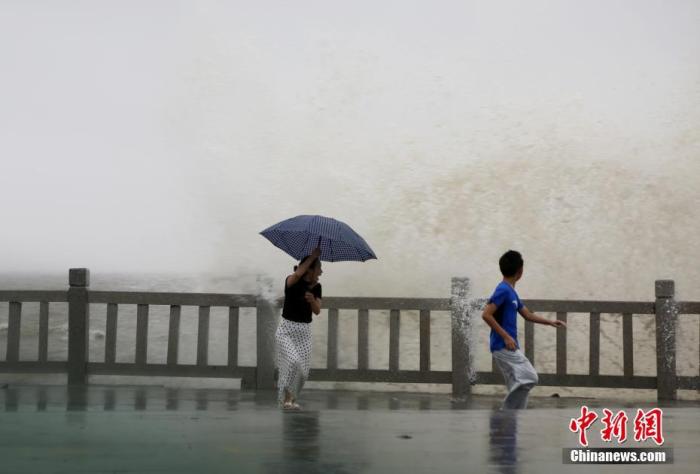China News Service, July 29, according to the WeChat official account of the Ministry of Emergency Management, on the 29th, the National Defense Office and the Ministry of Emergency Management further dispatched and deployed flood and typhoon prevention work.
On July 28, 2021, under the influence of Typhoon No. 6 this year, "Fireworks", Lianyungang City, Jiangsu Province was affected by violent storms along the coast. There were strong winds of magnitude 9 to 11 on the sea. The sea was choppy, and huge waves several meters high were set off on the shore.
Photo courtesy of Wang Chun by China News Agency. Source: cnsphoto
According to forecasts by the Meteorological Department, this year's No. 6 typhoon "Fireworks" entered Shandong during the day on the 29th and moved into the Bohai Sea on the morning of the 30th, gradually degenerating into an extratropical cyclone.
Affected by the "fireworks" and cold air, in the next three days, there will be heavy to heavy rains in northern Shandong, Beijing-Tianjin-Hebei, eastern Inner Mongolia, central and western parts of Northeast China, and heavy rains in some areas.
According to reports from the water resources department, in the next 24 hours, Taihu Lake and surrounding river network areas, Nenjiang Qiqihar to Dalaijiang section, Songhua River upstream Zhaoyuan section, Heilongjiang Tongjiang section, Shaying River Zhoukou section, and the middle and lower reaches of the Yangtze River Yangjiang, Chuhe, and some sections of the Weihe River in the southern part of the Haihe River will maintain over-alert or over-guaranteed water levels.
Huang Ming, deputy commander-in-chief of the State Defense Department and head of the Emergency Management Department, emphasized the need to strengthen bottom-line thinking, strengthen overall coordination, and more meticulously and accurately grasp various measures, and make every effort to fight this year's flood prevention and disaster relief battle.
On the 29th, Zhou Xuewen, Secretary-General of the State General Defense, Deputy Minister of Emergency Management and Deputy Minister of Water Resources, presided over the video conference and dispatch of flood prevention and typhoon prevention, and discussed and judged with the China Meteorological Administration, Ministry of Water Resources, and Ministry of Natural Resources. The video links Shandong, Henan, and China. Hebei, Tianjin, Liaoning and other places have further dispatched and deployed flood and typhoon prevention work.
The meeting emphasized that for the emergency rescue and disaster relief work in Henan Province, we must continue to do a good job in emergency rescue, transfer and resettlement of the affected people, speed up drainage and drainage in key areas, and conduct detailed disaster inspections.
In response to typhoon "fireworks" defense work, we must be highly vigilant about the changeable path of "fireworks". The Yellow River, Haihe River, Liaohe River and other river basins should pay close attention to the development and changes of water regime and flood conditions, rolling consultations and judgments, strengthening project scheduling, and doing a good job in dike inspections Emergency and rescue forces are in front.
Some sections of the Heilongjiang, Nenjiang, and Songhua River basins have been over-police for a long time, and the embankment has been soaked for a long time. It is necessary to carry out uninterrupted dyke inspections 24 hours a day, and timely and decisively transfer the threatened people.
The meeting requested that the current "seven lower and eight upper" flood control period is still in the critical period, and the flood control and disaster relief situation is severe and complex. All levels of prevention and control should accurately predict and forecast rain and water conditions, make rolling forecasts and short-term forecasts, and implement flood control measures in grassroots units. . It is necessary to accurately analyze and judge risks, and analyze and grasp the possible risks of changes in the water level and flow of local rivers, lakes and reservoirs based on meteorological and hydrological forecasts. It is necessary to accurately configure rescue and rescue forces, and preset rescue and rescue forces and materials in advance for possible risks. It is necessary to accurately and efficiently report disaster and dangerous information.

